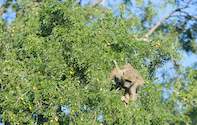A review of commercialised food plants in the world showed that Africa has made a important contribution with 119 species. This compares well with 126 for Europe, 68 for Central America and 97 for South America.

Of the 119 commercialised African plants, 16 are indigenous to southern Africa: these are gum Arabic (acacia gum), baobab, buchu, waterblommetjie, rooibos tea, sour fig, jelly melon (Cucumis metuliferus), honeybush tea, finger millet, palm wine (Hyphaene coriacea), pearl millet, Livingstone or African potato, marula, sorghum, Bambara groundnut and cowpea.
Indigenous South African food crops refer to crops that have their origin in South Africa as well as crops that were introduced into the country and are now considered to be traditional crops.
These crops are produced and found growing in the country in various climates with many found in the wild. Indigenous crops are divided into three categories; grains, vegetables and fruit.
South Africa has not focused much on indigenous food crops but the rest of the world has already started to appreciate its value. Kei apple (Dovyalis caffra) has been cultivated in California, jelly melons (Cucumis metuliferus) are produced commercially in France, Israel, California as well as New Zealand where it is known as kiwano.
Indigenous Grain Crops
Indigenous grain crops are seeds rich in starch and protein-enriched and suitable for eating. These crops are further divided into cereals and pulses. Cereals: Pearl millet, grain sorghum Pulses: Cowpea, bambara groundnut, mungbean, marama bean (seeds)Indigenous Vegetable Crops
Indigenous vegetable crops are plants from which the tender leaves, stems and stalks are harvested and used in the preparation for food. These crops are divided into roots/tubers and leaf vegetables. Leafy: cleome, cowpea, amaranth, blackjack, Jew’s mallow Roots/tubers: cassava, amadumbe, marama bean (tuber)Indigenous Fruit Crops
Indigenous fruit crops are the fleshy seed-associated structures that are sweet and edible in the raw state. Examples of fruit are marula, sourplum, monkey orange and sour fig.
In addition to their high nutritional value, indigenous fruits have another important advantage: they produce even when staple crops fail (e.g. during droughts), and can bridge the ‘hunger gap’ during times of food shortages. Read more about South African Indigenous Fruit Crops
Major Production Areas in South Africa
Amaranth, black jack, cleome and Jew’s mallow are the most widely used by rural communities and harvested in the wild. Bambara groundnut, cowpea grow in Mpumalanga, North West, Gauteng, KwaZulu-Natal and Limpopo provinces.
Cleome, Jews mallow, amaranthus are found in Mpumalanga, KwaZulu-Natal, North West and Gauteng provinces. Marula, sourplum, wild plum grow in Mpumalanga, KwaZulu-Natal, Limpopo and Eastern Cape provinces.
Uses of Indigenous Food Crops
Indigenous foods are eaten as boiled, dried and sometimes roasted vegetables and are also used as relish and in soups. Immature pods are dried or boiled while immature seeds are ground to make flour.
Tubers are used as food substitutes for starch-enriched food such as rice and maize meal. Fruit types are eaten in ripened or dried form or nuts and can be processed into jam, jelly and juice.